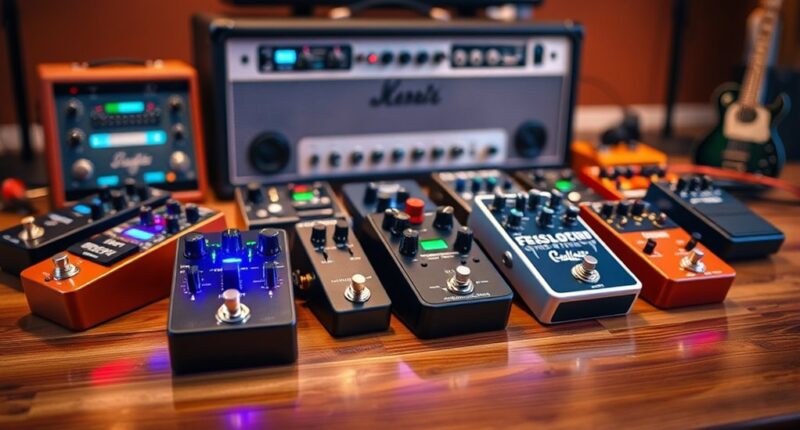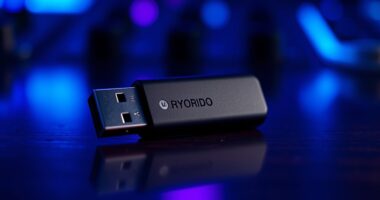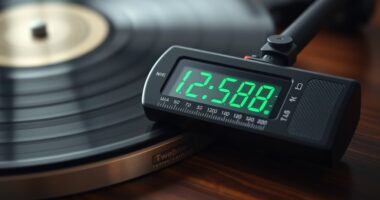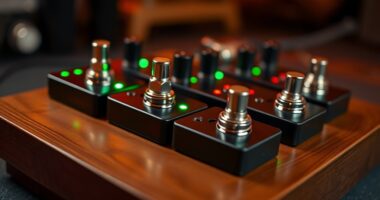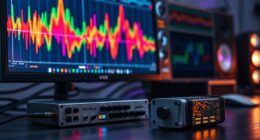If you’re looking to elevate your sound in 2025, I recommend exploring top guitar amp modeler pedals like the MOOER GE150, SONICAKE Pocket Master, Donner Arena 2000, and others that combine realistic amp tones, versatile effects, and portable designs. These units support third-party IRs, offer extensive preset options, and feature user-friendly controls. To find the perfect fit for your style and setup, check out the full list—we’ve got all the details you need to make a smart choice.
Key Takeaways
- The top amp modeler pedals offer extensive effects, amp models, and IR support for versatile, high-quality guitar tones.
- Portable and durable designs with rechargeable batteries make them ideal for practice, recording, and live performances.
- Advanced user interfaces and app integrations enable easy preset management and tone customization.
- Compatibility with third-party IR files and software enhances tonal flexibility and realism.
- Leading models deliver studio-grade sound quality with realistic amp/cabinet modeling, suitable for professionals and enthusiasts alike.
MOOER GE150 Electric Guitar Amp Multi Effects Pedal
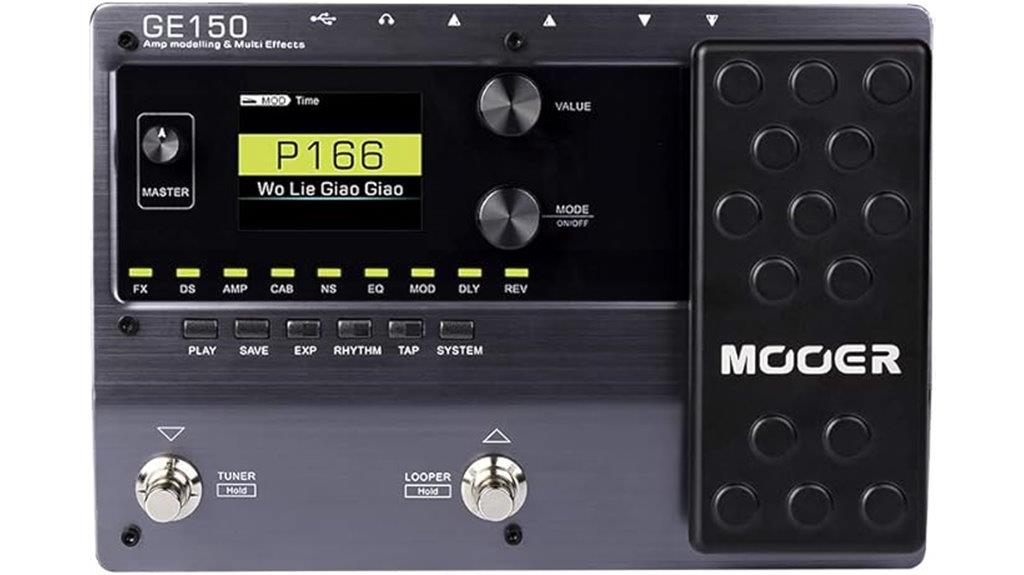
If you’re looking for a versatile and feature-rich pedal that can handle a wide range of musical styles, the MOOER GE150 is an excellent choice. It offers 151 effects and 55 high-quality amp models using MNRS technology, so you can craft almost any tone you desire. The pedal includes 26 user slots for third-party IR files, letting you recreate the feel of real tube amps. With its expression pedal, looper, drum rhythms, and metronome, it’s perfect for practice, recording, or live performance. Plus, USB connectivity makes sharing recordings easy, and you can upload or download presets from the Mooer Studio community.
Best For: musicians and guitarists seeking a versatile, multi-effects pedal with comprehensive tonal options for practice, recording, and live performances.
Pros:
- Extensive effects library with 151 effects and 55 amp models for versatile sound shaping
- Supports third-party IR files and preset sharing via Mooer Studio for creative customization
- Built-in looper, drum rhythms, metronome, and USB connectivity enhance practice and recording capabilities
Cons:
- The large number of features may present a learning curve for new users
- Some users may find the interface complex or overwhelming initially
- Limited onboard control options may require additional external gear for advanced setups
MOOER GE150 Pro Guitar Amp Multi-Effects Pedal
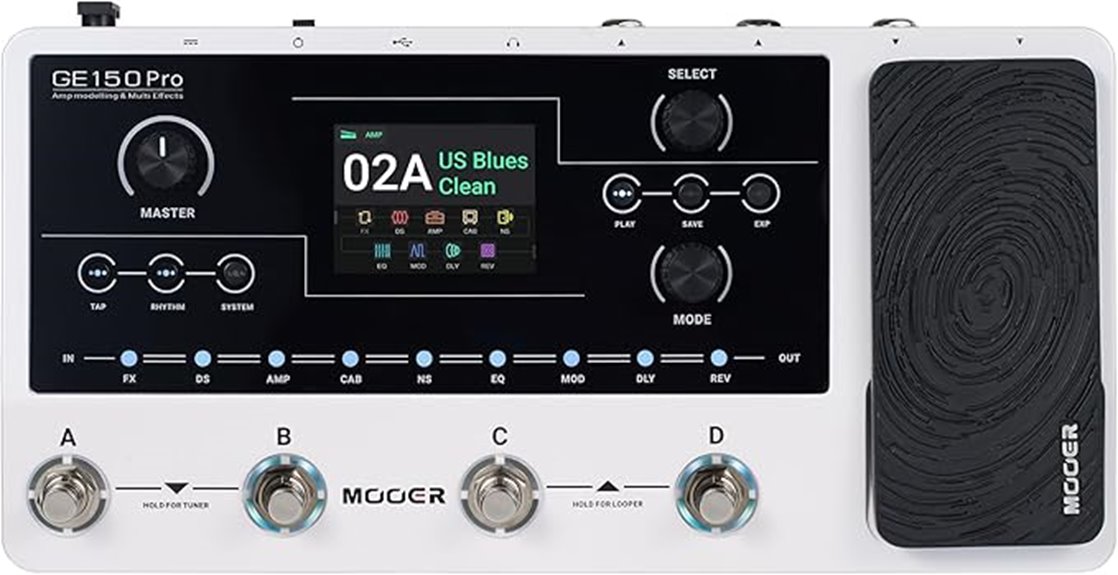
The MOOER GE150 Pro stands out as an ideal choice for guitarists who need versatile tones and effects in a compact, portable package. It offers 200 factory presets, including 55 classic amp models and 26 cabinet simulations, with support for custom IRs. Its flexible effect chain, looper, drum machine, and live recording features make it perfect for practice, gigs, or songwriting. The device’s intuitive interface, high-quality LCD, and multiple connectivity options—including USB-C, auxiliary input, and headphone jack—enhance usability. Its rechargeable battery in the Li edition adds outdoor convenience, making it a practical, budget-friendly tool for versatile performance.
Best For: beginner to intermediate guitarists seeking a versatile, portable multi-effects pedal for practice, gigs, and songwriting on a budget.
Pros:
- Extensive tone options with 200 presets, amp modeling, and cabinet simulations
- Compact, lightweight design with rechargeable battery for portability
- User-friendly interface with intuitive controls and versatile connectivity options
Cons:
- Build quality concerns, especially the flimsy expression pedal
- LCD display visibility can be challenging in certain lighting conditions
- Minimal included instructions, requiring users to experiment to learn features
SONICAKE Pocket Master Portable Multi Effects Pedal for Guitar and Bass

Designed for musicians who need versatile effects on the go, the SONICAKE Pocket Master Portable Multi Effects Pedal stands out with its extensive digital modeling technology. It offers over 100 effects, including 20 amp models, plus support for custom IR files, making it highly customizable. The device features a clear LCD screen, 99 drum rhythms, a 10-second looper, and flexible signal chains with up to nine effects at once. Its compact size, rechargeable battery, and easy-to-use app make it perfect for practice, recording, and travel. Overall, it delivers impressive sound quality and versatility at a budget-friendly price, making it a great choice for mobile players.
Best For: musicians seeking a portable, versatile multi-effects pedal for practice, recording, and travel that offers high-quality tones and extensive customization options.
Pros:
- Wide range of over 100 effects, including 20 amp models, with support for custom IR files for personalized tone shaping
- Compact, lightweight design with rechargeable battery, ideal for on-the-go use and easy transport
- User-friendly app interface for deep preset customization, IR loading, and firmware updates
Cons:
- Not primarily designed as a foot pedal; switch accessibility may be less convenient for live foot operation
- Some users find menu navigation challenging initially, requiring familiarization to use effectively
- While versatile, certain presets and effects may vary in quality, and it might not fully replace dedicated larger units for complex live setups
Donner Arena 2000 Guitar Effects Pedal

The Donner Arena 2000 Guitar Effects Pedal stands out as a top choice for guitarists seeking versatile tones and professional-grade effects in one compact unit. It features FAVCM technology with high-precision 24-bit/44.1 kHz audio processing, delivering rich, layered sounds that avoid digital harshness. With 278 effects, including classic effects, amp, and cabinet simulations, it covers nearly every genre. The pedal offers 50 IRs plus third-party IR banks for authentic tone restoration, along with a 60-second looper and drum rhythms for practice and recording. Its customizable controls, app management, and multiple connectivity options make it a powerful, studio-ready tool for both live and recording use.
Best For: guitarists seeking versatile, high-quality effects and tone restoration in a compact, studio- and stage-ready pedal.
Pros:
- Advanced FAVCM technology provides rich, layered sound with minimal digital harshness.
- Extensive effects library (278 types), including classic, amp, and cabinet simulations, suitable for a wide range of genres.
- Multiple connectivity options and app integration allow for easy tone customization and live performance management.
Cons:
- No built-in battery compartment, requiring an external power source.
- High-impedance headphones may result in lower volume output.
- Slightly complex setup for beginners unfamiliar with digital effects and app-based editing.
MOOER GE150 Guitar Amp Multi Effects Processor
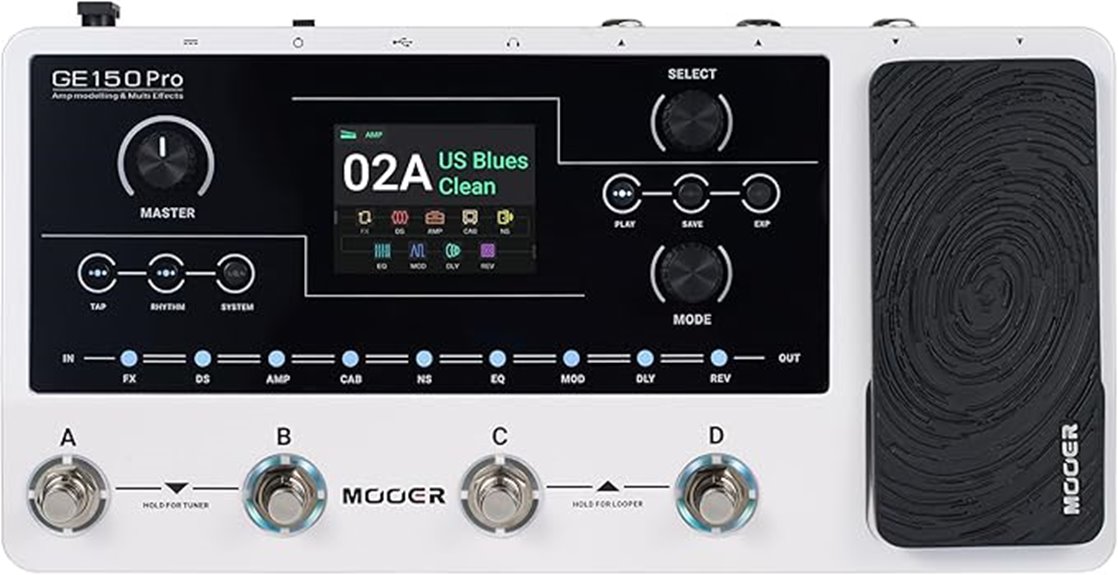
If you’re looking for a versatile and portable multi-effects processor that delivers a wide range of tones, the MOOER GE150 is an excellent choice. It offers 200 factory presets, 55 amp models, and 26 cabinet simulations, plus support for custom IRs. Its flexible effect chain, looper, drum machine, and live recording features make it perfect for practice, gigs, or studio work. The built-in effects include reverbs, delays, distortions, and more, all controlled via intuitive controls and a clear LCD screen. With USB-C connectivity and a rechargeable battery option, the GE150 combines convenience, variety, and quality, making it a solid tool for any guitarist.
Best For: beginner to intermediate guitarists seeking a versatile, portable, and budget-friendly multi-effects processor for practice, gigs, or studio recording.
Pros:
- Extensive tone options with 200 presets, 55 amp models, and 26 cabinet simulations
- Built-in looper, drum machine, and live recording features for songwriting and practice
- Compact, lightweight design with rechargeable battery for portability and outdoor use
Cons:
- Build quality issues, particularly with the flimsy expression pedal
- LCD screen visibility can be challenging in certain lighting conditions
- Minimal included instructions, requiring users to experiment and learn through trial and error
Donner Arena 2000 Guitar Effects Pedal
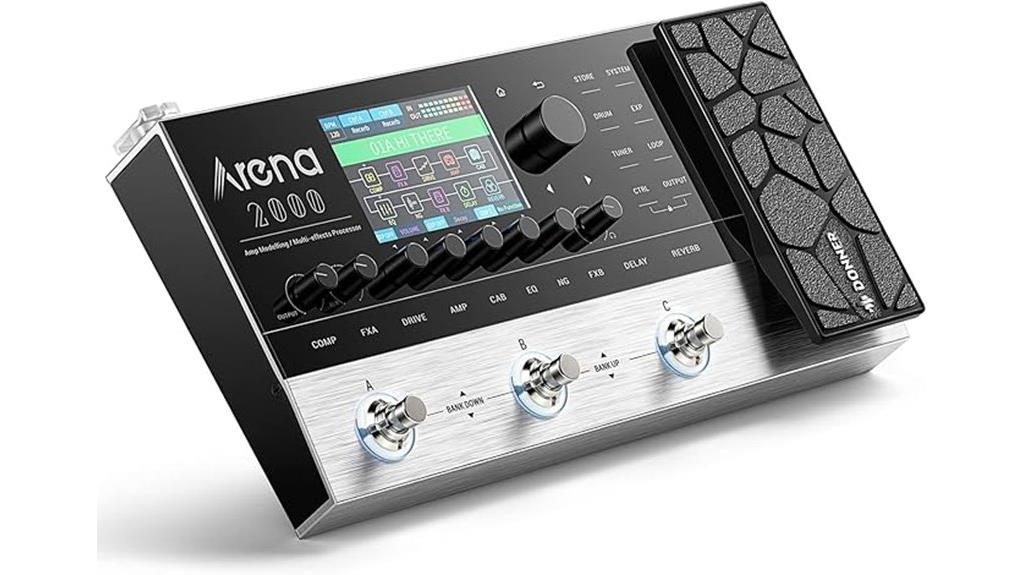
For guitarists seeking versatile tone-shaping tools, the Donner Arena 2000 Guitar Effects Pedal stands out with its advanced FAVCM technology and extensive effect library. Its high-precision 24-bit/44.1 kHz audio processing delivers rich, layered sounds without digital harshness. With 278 effects—including classic, amp, and cabinet simulations—it covers genres from pop to metal. The pedal’s IR capabilities, with 50 built-in and third-party IRs, add authentic space and depth. Performance features like drum rhythms, a looper, and multiple connectivity options make it ideal for recording or live use. Plus, the customizable controls and app integration ensure tailored tones for any playing style.
Best For: guitarists and sound engineers seeking a versatile, high-quality effects pedal with extensive tone-shaping capabilities for studio recording and live performances.
Pros:
- Advanced FAVCM technology with high-precision audio processing for rich, layered sound quality
- Wide variety of 278 effects including classic, amp, and cabinet simulations covering multiple genres
- Extensive IR support with 50 built-in and third-party IR banks for realistic space and depth
Cons:
- No built-in battery compartment, requiring external power sources
- High impedance headphones (above 64 ohms) may result in lower volume levels
- Complex feature set may require learning curve for optimal use through the app and controls
MOOER GE100 Multi-Effects Guitar Pedal

The MOOER GE100 Multi-Effects Guitar Pedal stands out as an excellent choice for players seeking versatility on a budget. With 80 preset patches and 80 user patches, it offers a vast sound library. Equipped with 8 effect modules spanning 66 effect types, it provides a wide tonal palette. Its large, bright display makes navigation easy, and its durable metal construction ensures longevity. The pedal includes a 180-second looper and built-in drum machine, perfect for practice and songwriting. Despite some presets sounding digital or over-the-top, users can tweak settings to craft their ideal tone, making it a flexible option for all skill levels.
Best For: beginners and budget-conscious guitar players seeking a versatile multi-effects pedal for practice, recording, and stage use.
Pros:
- Extensive sound library with 80 preset and 80 user patches for versatile tonal options
- Durable metal construction with a large, bright display for easy navigation
- Built-in looper and drum machine enhance practice and songwriting sessions
Cons:
- Some presets may sound artificial or overly digital, requiring tweaking for desired tones
- Firmware update process can be challenging and limited compatibility in European markets
- Limited high-end boutique effect tones; mainly suitable for general practice and live use
IK Multimedia TONEX One AI Multi-Effects Pedal
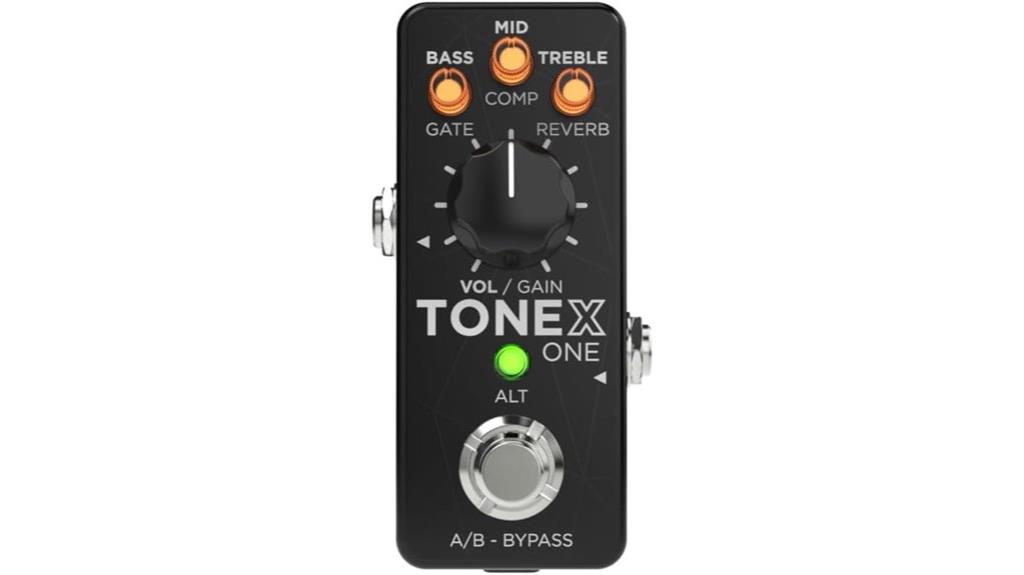
The IK Multimedia TONEX One AI Multi-Effects Pedal stands out as an ideal choice for musicians seeking portable, high-fidelity amp and effects modeling without sacrificing ease of use. It offers 20 presets, supporting load, A/B, and on/off modes, and connects easily via 1/4 inch out to amps, PA, or FRFR cabs. With onboard tuner, EQ, gate, compressor, and reverb, it covers essential effects. Its compact metal body makes it highly portable, while the TONEX Librarian provides access to over 25,000 Tone Models. Despite software quirks, users praise its realistic tones, especially for practice, backup, or direct recording, making it a versatile, budget-friendly option.
Best For: musicians seeking a portable, high-quality amp and effects modeling solution for practice, recording, or backup use that is affordable and easy to integrate.
Pros:
- Provides realistic amp, cab, and effect tones comparable to higher-end products at an accessible price
- Compact, durable metal body with multiple pedal chain options and customizable knobs for versatility
- Supports extensive tone modeling via TONEX Librarian’s 25,000+ models and software for editing and organization
Cons:
- Limited interface features, only two footswitch modes and no bypass or MIDI control
- Software can be complex, buggy, and may require patience to navigate and troubleshoot
- Lacks advanced features like LED display and comprehensive control options found in higher-end models
Leo Jaymz Portable Multi-Effects Guitar/Bass Amplifier (Modeler Effects Processor)
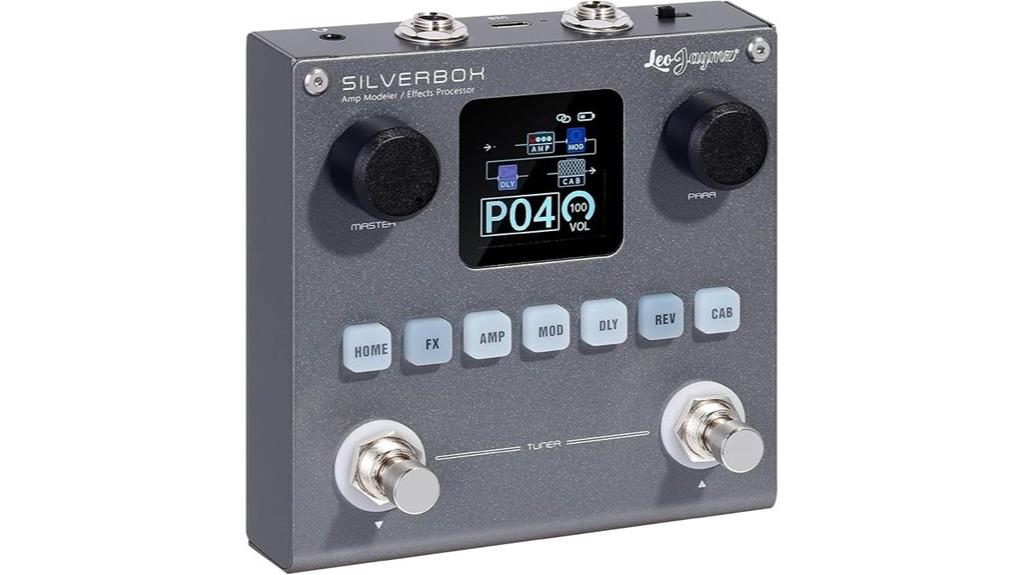
If you’re looking for a highly portable and versatile effects processor that can handle practice, recording, and casual gigs, the Leo Jaymz Portable Multi-Effects Guitar/Bass Amplifier is an excellent choice. Weighing just over a pound in a sturdy aluminum case, it offers up to 10 hours of rechargeable power via USB-C. It supports a wide range of effects, modeling options, and 80 presets—perfect for crafting your sound on the fly. Connectivity is straightforward with Bluetooth, USB, and standard jacks, making it compatible with smartphones and computers. While it’s mainly suited for practice and recording, its compact size and rich features make it a valuable tool for musicians seeking portable tone shaping.
Best For: musicians and hobbyists seeking a portable, versatile effects processor for practice, recording, and casual gigs with easy connectivity and customizable sounds.
Pros:
- Compact and lightweight design makes it highly portable for on-the-go use.
- Wide range of effects, presets, and modeling options for versatile sound shaping.
- Rechargeable battery provides up to 10 hours of use, eliminating the need for external power sources.
Cons:
- Small interface and manual font size may be challenging for some users to navigate initially.
- Sound quality and effects realism can be inconsistent compared to larger, more advanced units.
- Not recommended for professional live stage performances due to its fragility and size.
LEKATO Multi Effects Guitar Pedal with Presets and Modules
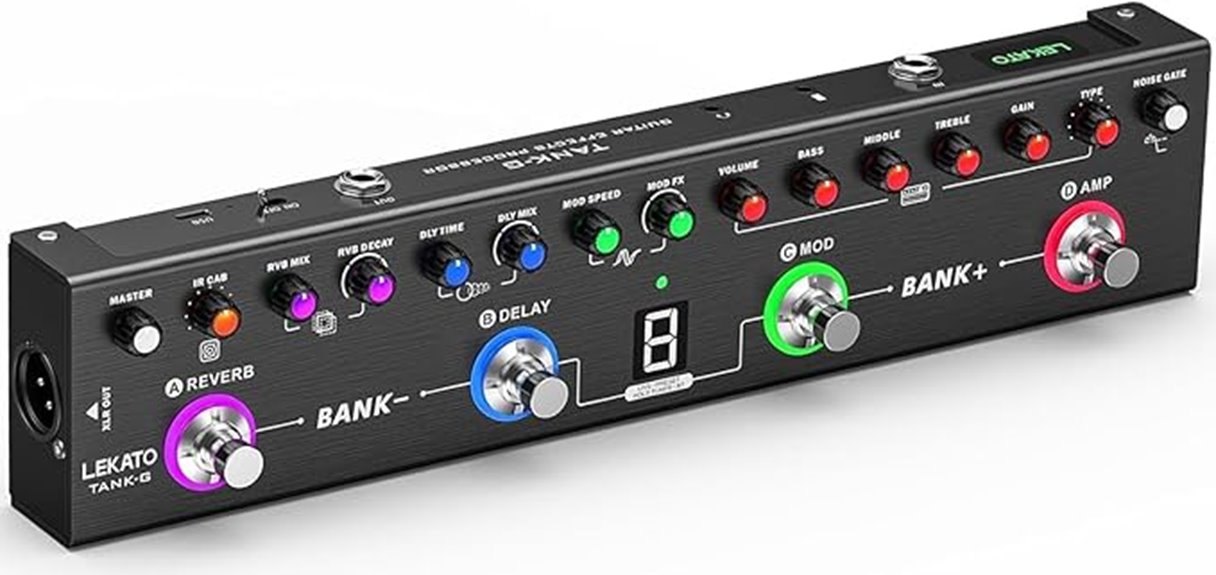
For guitarists who want versatile tone shaping and deep customization options, the LEKATO Multi Effects Guitar Pedal with Presets and Modules stands out as an excellent choice. It features 36 presets with rich effects chains, including amp models, modulation, delay, reverb, and IR cab simulations. You can overwrite presets and save your own settings, while knobs let you fine-tune each effect. The pedal integrates with a dedicated app for advanced editing, sharing, and IR management. With multiple connectivity options—USB, XLR, Bluetooth—and a rechargeable battery offering up to 12 hours, it’s perfect for practice, recording, or live performances. Its user-friendly design makes crafting your signature tone effortless.
Best For: guitarists seeking versatile tone shaping, deep customization, and comprehensive recording and performance features in a portable, user-friendly pedal.
Pros:
- Extensive effects and preset options with the ability to overwrite and save personalized tones
- Advanced app integration for editing, sharing, and IR management, plus support for third-party IRs
- Multiple connectivity options including USB, XLR, Bluetooth, and a long-lasting rechargeable battery
Cons:
- May have a learning curve for beginners unfamiliar with advanced editing features
- Slightly larger footprint compared to simpler pedals, potentially less portable for minimal setups
- Reliance on app for full customization might be challenging for users without smartphone or PC access
FRFR-GO 30W Electric and Bass Guitar Amplifier
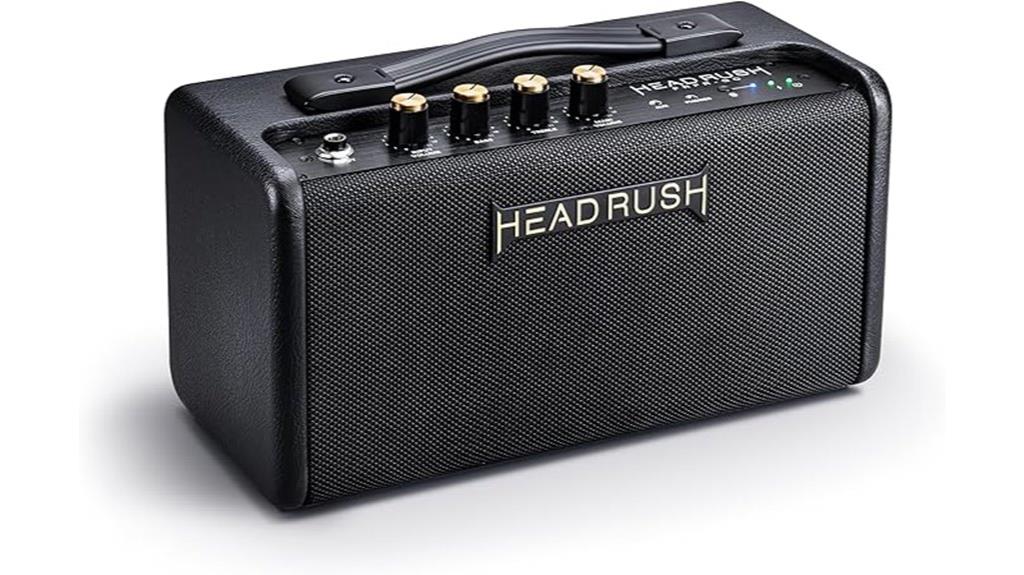
Designed for guitarists and bass players who need a portable, high-quality practice amplifier, the FRFR-GO 30W stands out with its compact size and versatile features. Its sleek, desktop design measures just 12.6 x 7.2 x 5.9 inches and weighs only 7.37 pounds, making it easy to carry with the built-in handle. Dual 3-inch speakers deliver accurate, flat-response sound, perfect for amp modelers. It offers stereo aux input, line-level input, EQ controls, Bluetooth streaming, and a rechargeable battery that lasts up to 13 hours. Whether at home, outdoors, or on the go, FRFR-GO delivers reliable, clear sound with flexible connectivity.
Best For: guitarists and bassists seeking a portable, high-quality practice amplifier with versatile connectivity for home, outdoor, or travel use.
Pros:
- Compact, lightweight design with a built-in handle for easy portability
- Accurate full-range sound with dual 3-inch speakers ideal for amp modeling
- Long-lasting rechargeable battery offering up to 13 hours of continuous use
Cons:
- Limited power output at 30W may not be suitable for large venues or loud band settings
- Might lack advanced effects or additional speaker outputs found in larger amps
- Bluetooth and input connections may require careful setup to avoid interference
NUX NGS-6 Amp Modeler Guitar Pedal
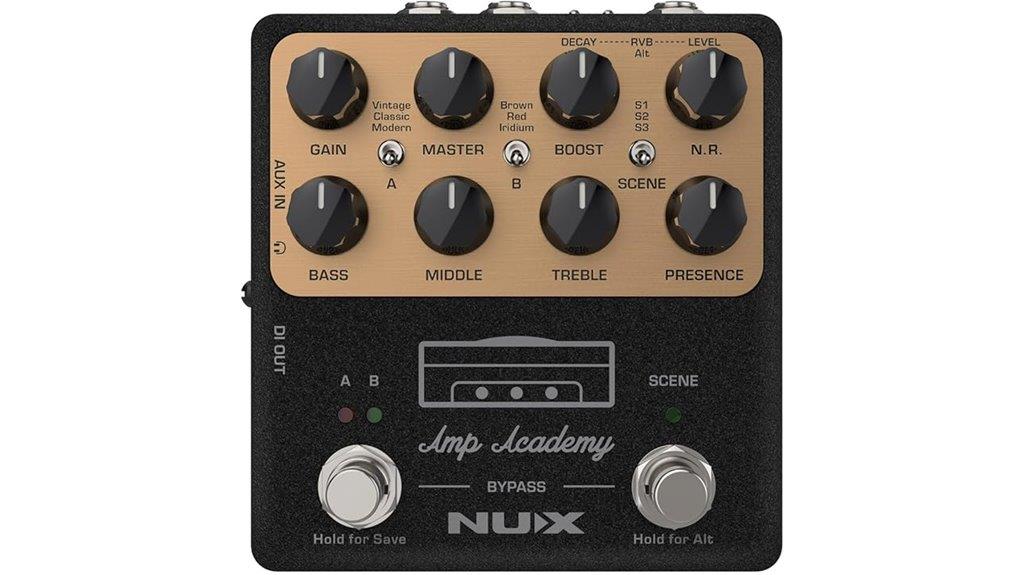
The NUX NGS-6 Amp Modeler Guitar Pedal stands out for musicians seeking high-quality amp tones in a compact, versatile package. With 1024 samples IR resolution and support for third-party IR loaders, it offers rich, authentic sounds. Perfect for live gigs, you can connect it to pedal chains, mixers, or PA systems, giving you excellent control and flexibility. It also works directly with recording interfaces for studio-quality tones without the hassle of amps or microphones. The pedal features A/B amp and scene footswitches, making quick sound changes effortless. Designed for international markets, it’s a reliable, adaptable tool to elevate your guitar sound in any setting.
Best For: musicians and guitarists seeking high-quality amp tones in a compact, versatile pedal suitable for live performances and studio recordings.
Pros:
- Supports 1024 samples IR resolution and third-party IR loader for authentic, customizable sounds
- Easy to switch between sounds using A/B amp and scene footswitches for live or recording sessions
- Compatible with pedal chains, mixers, PA systems, and recording interfaces for flexible use
Cons:
- May differ in fit, age ratings, language, or instructions in international versions
- Limited to guitar sound shaping; not suitable for other instruments
- Requires understanding of IR loading and amp modeling for optimal use
FLAMMA FX100 Guitar Multi-effects Pedal

If you’re looking for a versatile and feature-rich multi-effects pedal, the FLAMMA FX100 stands out as an excellent choice. It offers nine effect blocks, including distortion, modulation, delay, and reverb, with over 150 effects total. You can run up to nine effects simultaneously, giving you endless sound options. With 55 high-quality amp models and 200 presets, it captures both classic and modern tones, all powered by authentic digital modeling. Plus, its recording features, including an 80-second looper and drum machine options, make it perfect for practice, live gigs, or streaming. Connectivity to PCs and mobile devices adds flexibility, making it a true all-in-one solution.
Best For: musicians and guitarists seeking a versatile, all-in-one effects pedal for practice, recording, and live performance.
Pros:
- Over 150 effects with up to nine used simultaneously for versatile sound shaping
- 55 high-quality amp models and 200 presets for a wide range of tones
- Recording features including an 80-second looper and drum machine options for creative flexibility
Cons:
- The extensive features may have a learning curve for beginners
- Limited to 9 effects at a time, which might restrict more complex setups
- Requires USB connection for software updates and preset editing, which may be less convenient for some users
VALETON GP-200 Multi-Effects Guitar and Bass Pedal
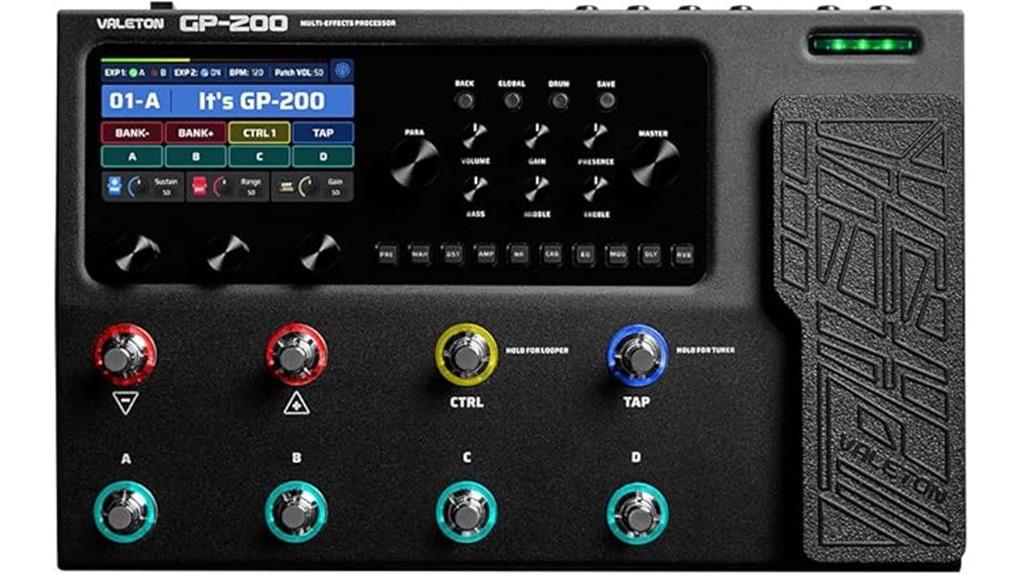
For guitarists and bassists seeking a versatile, all-in-one effects pedal, the VALETON GP-200 stands out thanks to its extensive selection of over 240 effects, including legendary amp and cabinet simulations. It offers 140 amp and cab models, plus 100 stompbox effects, with support for third-party IRs. The 24-bit processing guarantees high sound quality, and you can run up to 11 effects simultaneously. With 256 presets, 100 drum rhythms, and an 180-second looper, it’s perfect for practice and performance. Its intuitive 4.3-inch color display, multiple connectivity options, and mobile compatibility make it a thorough tool for players seeking flexibility and ease of use.
Best For: guitarists and bassists who need a versatile, all-in-one effects pedal with extensive sound-shaping options, live performance features, and easy mobile integration.
Pros:
- Over 240 built-in effects, including legendary amp and cabinet models for diverse tone options
- Intuitive 4.3-inch TFT color display with user-friendly interface and customizable controls
- Supports multiple effects simultaneously (up to 11), with presets, drum rhythms, and looper for versatile practice and performance
Cons:
- The extensive features and menu options may require a learning curve for beginners
- Larger footprint due to full-color display and multiple connectivity ports may not suit tight setups
- Limited to 180 seconds of looping time, which might be restrictive for some users
Factors to Consider When Choosing Guitar Amp Modeler Pedals

When choosing a guitar amp modeler pedal, I focus on how versatile its tone options are and how many effects and amp models it offers. I also consider how easy it is to use, including connectivity features and how much I can customize presets. These factors help me find a pedal that fits my playing style and setup perfectly.
Tone Versatility Options
Choosing a guitar amp modeler pedal with versatile tone options means considering how many amp and effect models it offers, as well as how easily you can customize those sounds. I look for pedals with over 200 presets and at least 55 amp types, allowing me to explore a wide range of genres. Support for third-party IR loading is a huge plus, as it helps create authentic cabinet tones. Multiple effect blocks—up to 11—enable me to layer modulation, delay, reverb, and distortion effects for unique sounds. Advanced modeling technologies like MNRS or non-linear digital amp simulation add realism and dynamic response. Plus, preset memory and user-assignable parameters make switching between tones quick and straightforward, ensuring I adapt easily to different musical contexts.
Effect and Amp Selection
Selecting the right guitar amp modeler pedal hinges on its variety and realism of built-in amp and effect models. I look for pedals offering between 55 and over 200 options, ensuring a broad palette for different genres and tones. The ability to load third-party impulse responses (IRs) is essential—it allows me to customize cabinet and tone characteristics precisely. I also consider pedals that support multiple effects simultaneously, with at least nine effect blocks, to craft complex sounds. Flexible signal routing is another key feature; pedals supporting up to 11 effect blocks in a chain give me maximum versatility. Ultimately, I prioritize amp modeling technology like MNRS or non-linear digital simulation, which delivers authentic tube amp response and a dynamic feel I can truly connect with.
Ease of Use
A user-friendly interface is essential because it allows me to navigate menus, adjust settings, and tweak tones quickly without frustration. Clear menus, dedicated knobs, buttons, and displays make customizing sounds straightforward. Intuitive controls like footswitches and preset banks enable seamless switching during practice or gigs, saving time and effort. Well-organized menus and labeled functions help minimize the learning curve, so I can set up quickly and focus on playing. Features like scene memory, assignable controls, and preset management simplify complex setups and let me recall my favorite tones instantly. Additionally, compatibility with mobile apps or software provides visual, guided editing, making it easier to manage presets and fine-tune sounds without digging through menus. Overall, ease of use enhances both practice and performance.
Connectivity Features
When evaluating guitar amp modeler pedals, it’s important to take into account their connectivity options to assure they fit seamlessly into your setup. Look for pedals with multiple input and output options, like 1/4-inch mono/stereo jacks, auxiliary inputs, and headphone outputs, to accommodate different scenarios. USB or OTG connectivity is also valuable for firmware updates, preset management, and direct recording to computers or mobile devices. Wireless features like Bluetooth enable flexible practice and playback. Compatibility with external devices such as mixers, PA systems, and third-party IR loaders is essential for versatile live performance. Additionally, check for MIDI or external control jacks if you want advanced live control or integration with other gear, making your setup more dynamic and intuitive.
Preset Customization
Since preset customization is key to shaping your unique tone, it’s important to choose a guitar amp modeler pedal that offers flexible editing options. Look for pedals that let you tweak effects, amp models, and parameters easily, so you can craft sounds that suit your style perfectly. The ability to overwrite and save presets is vital for quick access during gigs or recording sessions. Many pedals support importing third-party IR files and custom effects, expanding your tonal palette. User-friendly interfaces, whether through app integration or onboard controls, make editing straightforward. Advanced preset management features, like preset banks and quick switching, are essential for versatile live setups. These options ensure you can adapt your sound effortlessly, whether in the studio or on stage.
Portability and Power
Choosing a guitar amp modeler pedal that’s portable and powerful guarantees you can take your tone anywhere without compromise. These pedals typically weigh less than 3 pounds and have compact designs, making them perfect for practice or gigs on the go. Many come with rechargeable batteries offering 8 to 13 hours of wireless operation, so you’re not tethered to a power outlet. Some models include USB-C or other connectivity options, allowing quick firmware updates and preset management without fuss. Power choices vary from AC adapters to rechargeable batteries, giving you flexibility depending on your needs. The lightweight build and self-contained power source make these pedals ideal for musicians who want high-quality sound and mobility. You can perform confidently, knowing your tone travels with you effortlessly.
Software Compatibility
Ensuring your guitar amp modeler pedal is compatible with your preferred software setup is essential for a smooth workflow. First, check that it supports your operating system—Windows, macOS, iOS, or Android—so you can easily integrate it into your setup. Compatibility with third-party IR loaders and tone editing software allows you to customize your sound extensively, giving you more creative control. Make sure the firmware and software are regularly updated; this improves stability, adds features, and fixes bugs. It’s also helpful if the manufacturer offers dedicated apps for preset management, tone editing, and backups. Finally, verify that the pedal works with common DAWs and MIDI control to ensure seamless integration into recording and live performance environments.
Build Quality
A guitar amp modeler pedal’s build quality directly impacts its durability and reliability, especially if you plan to use it regularly or take it on the road. High-quality materials, like a sturdy metal chassis, guarantee it can withstand impacts and rough handling during performances or transport. Robust switches and sealed potentiometers and jacks protect against dust and moisture, which can otherwise shorten the pedal’s lifespan. Well-made enclosures help minimize unwanted noise or interference caused by loose or poorly shielded components. Additionally, good craftsmanship often means better internal components, resulting in more consistent and reliable performance over time. When choosing a pedal, prioritize build quality to assure it remains a dependable part of your rig, regardless of how often or where you gig.
Frequently Asked Questions
How Do Amp Modeler Pedals Impact Live Performance Dynamics?
Amp modeler pedals substantially boost my live performance dynamics by offering a wide range of tones and effects at the tap of a footswitch. They let me switch seamlessly between different sounds, creating a more engaging and versatile performance. Plus, I can easily adapt to different venues and styles without lugging multiple amps. This flexibility keeps my sound fresh and my audience captivated from start to finish.
Can These Pedals Emulate Vintage Amplifier Tones Accurately?
Yes, these pedals can emulate vintage amplifier tones quite accurately. I’ve found that many models use advanced digital algorithms to capture the nuances of classic amps, from their clean chime to gritty overdrive. While they might not perfectly replicate every subtlety, they come remarkably close, giving me authentic vintage sounds without needing bulky gear. It’s like having a whole collection of classic amps at my feet, ready to dial in.
What Is the Typical Learning Curve for Beginners Using These Devices?
Getting started with these pedals is a bit like learning to ride a bike—there’s a learning curve, but it’s manageable. As a beginner, I found that spending time with the manual and experimenting helps a lot. Most pedals come with presets to get you going, so you’re not lost at sea. With patience, I quickly found my groove, and now I enjoy shaping my sound effortlessly.
Are There Specific Features Crucial for Recording Studio Use?
For recording studio use, I look for features like high-quality amp modeling, versatile effects, and precise tone control. A good pedal should offer seamless integration with my recording setup, including MIDI compatibility and multiple output options. I also value user-friendly interfaces for quick adjustments and the ability to save presets. These features help me capture the perfect sound and guarantee flexibility during mixing and production.
How Do Power Requirements Vary Among Different Modeler Pedals?
They say “know your power,” and I agree. Power requirements vary among modeler pedals—some run on standard 9V batteries or adapters, while others need 12V or even 18V for the best performance. I always check each pedal’s specs beforehand to make certain I’ve got the right power supply. Using the wrong power source can cause noise or damage, so it’s worth paying attention to these details to keep your sound clean.
Conclusion
Think of choosing a guitar amp modeler pedal like planting a seed. With the right one, you nurture your sound, watch it grow, and watch your musical garden blossom. Each pedal is a unique seed—some sprout quickly, others need more patience. Trust your instincts, nurture your creativity, and soon you’ll be cultivating a sound that’s truly yours. After all, your best music begins with the right foundation.
